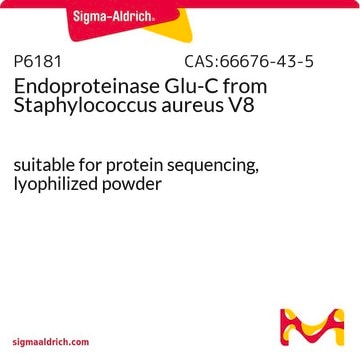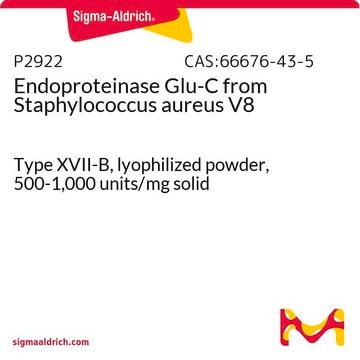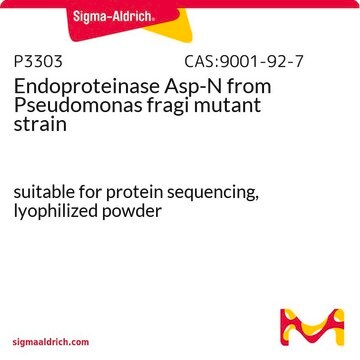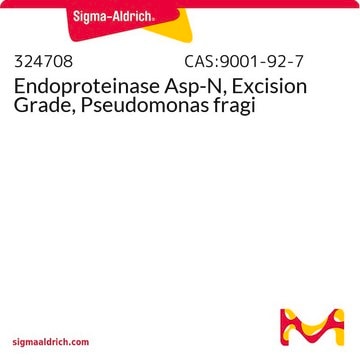10791156001
Roche
Endoproteinase Glu-C (V8 Protease)
from Staphylococcus aureus V8
Synonym(s):
V8 protease, protease v8
Sign Into View Organizational & Contract Pricing
All Photos(1)
About This Item
Recommended Products
form
lyophilized (salt-free)
specific activity
20 U/mg
mol wt
30 kDa
packaging
pkg of 2 mg
manufacturer/tradename
Roche
optimum pH
8.0-8.5
Related Categories
General description
Approximately 20 U/mg lyophilizate at +25°C with Z-Phe-Leu-Glu-4-nitranilide as the substrate (approximately 500 U/mg lyophilizate at +37°C with casein as the substrate).
At 25 °C with Z-Phe-Leu-Glu-4-nitranilide as the substrate (approximately 500 U/mg lyophilizate at 37 °C with casein as the substrate).
Endoproteinase Glu-C is a Staphylococcal serine proteinase. Its inhibitors are DFP, α2-macroglobulin and TLCK.
Specificity
Heat inactivation: Endoproteinase Glu-C is inactivated by boiling for ten minutes.
Application
Use Endoproteinase Glu-C (V8 Protease) for protein structure analysis and for sequence analysis.
Biochem/physiol Actions
Endoproteinase Glu-C specifically hydrolyzes peptide and ester bonds at the carboxylic side of Glu, or both Glu and Asp, depending on the buffer used.
Preparation Note
Activator: The enzyme has its maximal activity in presence of SH-reagents
Working concentration: 1 to 5 mM
Working solution: Recommended solvent is 50 mM ammonium acetate pH 4.0 (2 mg/ml).
Storage conditions (working solution): -15 to -25 °C
The enzyme (2 mg/ml in 50 mM ammonium acetate, pH 4.0) is stable for at least one month, frozen in aliquots and thawed only once.
Working concentration: 1 to 5 mM
Working solution: Recommended solvent is 50 mM ammonium acetate pH 4.0 (2 mg/ml).
Storage conditions (working solution): -15 to -25 °C
The enzyme (2 mg/ml in 50 mM ammonium acetate, pH 4.0) is stable for at least one month, frozen in aliquots and thawed only once.
Storage and Stability
Store at 2 to 8 °C. (Store dry!)
Other Notes
For life science research only. Not for use in diagnostic procedures.
Signal Word
Danger
Hazard Statements
Precautionary Statements
Hazard Classifications
Eye Irrit. 2 - Resp. Sens. 1 - Skin Irrit. 2 - STOT SE 3
Target Organs
Respiratory system
Storage Class Code
11 - Combustible Solids
WGK
WGK 1
Flash Point(F)
does not flash
Flash Point(C)
does not flash
Certificates of Analysis (COA)
Search for Certificates of Analysis (COA) by entering the products Lot/Batch Number. Lot and Batch Numbers can be found on a product’s label following the words ‘Lot’ or ‘Batch’.
Already Own This Product?
Find documentation for the products that you have recently purchased in the Document Library.
Neha Garg et al.
Biopolymers, 106(6), 834-842 (2016-05-15)
The biosynthesis of the class II lanthipeptide geobacillin II was reconstituted in vitro. The purified precursor peptide was modified by the lanthipeptide synthetase GeoM at temperatures ranging between 37 and 80°C demonstrating the thermostability of the enzyme. Geobacillin II shares
Rosalynn C Molden et al.
Current protocols in protein science, 77, 23-23 (2014-08-02)
Histones are chromatin proteins that are highly modified with many different types of post-translational modifications. These modifications act in concert to regulate a number of chromatin-related processes. However, identification and quantification of co-occurring histone post-translational modifications is challenging because there
Petr Pompach et al.
Journal of proteome research, 11(3), 1728-1740 (2012-01-14)
Glycoproteins fulfill many indispensable biological functions, and changes in protein glycosylation have been observed in various diseases. Improved analytical methods are needed to allow a complete characterization of this complex and common post-translational modification. In this study, we present a
Marion Avril et al.
PLoS pathogens, 9(6), e1003430-e1003430 (2013-07-05)
During blood stage infection, Plasmodium falciparum infected erythrocytes (IE) bind to host blood vessels. This virulence determinant enables parasites to evade spleen-dependent killing mechanisms, but paradoxically in some cases may reduce parasite fitness by killing the host. Adhesion of infected
Tianshi Wang et al.
Molecular cell, 75(4), 823-834 (2019-07-16)
Sirt3, as a major mitochondrial nicotinamide adenine dinucleotide (NAD)-dependent deacetylase, is required for mitochondrial metabolic adaption to various stresses. However, how to regulate Sirt3 activity responding to metabolic stress remains largely unknown. Here, we report Sirt3 as a SUMOylated protein in
Our team of scientists has experience in all areas of research including Life Science, Material Science, Chemical Synthesis, Chromatography, Analytical and many others.
Contact Technical Service










